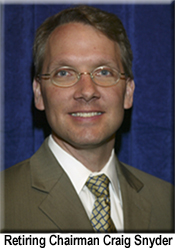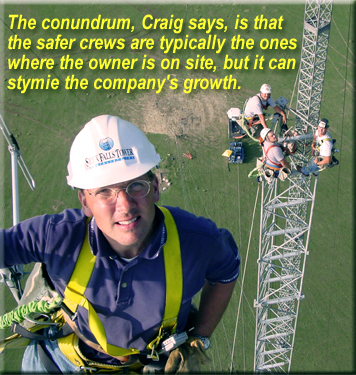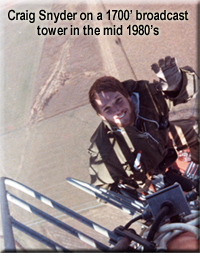|
Snyder set to hand over National Association of Tower Erectors' reins to new leadership
October 5, 2005 -- After serving four years as Chairman of the National Association of Tower Erectors, Craig Snyder has elected not to run as a director for the  organization and will be leaving his leadership role on February 13, 2006 when NATE's newly seated board will select a new chairman. Craig's industry knowledge, organizational skills and boundless energy have helped the association move forward during a period that saw a precipitous drop in business as well as a resurgence today that has tower erection companies scrambling for employee resources. organization and will be leaving his leadership role on February 13, 2006 when NATE's newly seated board will select a new chairman. Craig's industry knowledge, organizational skills and boundless energy have helped the association move forward during a period that saw a precipitous drop in business as well as a resurgence today that has tower erection companies scrambling for employee resources.
Craig is the president and CEO of Sioux Falls Tower & Communications and is a founding member of NATE and has served on the board of directors since the association's inception in 1995.
He also serves as the Chairman of Telecommunications Industry Association committee that reviews and writes the TIA 222 Structural Standards for Steel Antenna Towers and Antenna Supporting Structures. He has held this position since 1998.
Gratifications and frustrations surfaced during his leadership and Craig spent time with WirelessEstimator.com last week to discuss them.
W.E.: What is your most gratifying work accomplished as chairman of NATE for the past four years?
C.S.: NATE does a lot of work to promote safety in the industry. I look to the partnering we have experienced with OSHA, the creation of the national Climber Training Standard, the Hoist Operator Guidelines booklet and many other educational projects we have undertaken in my time as Chairman as good accomplishments. But what I will look back at with the most fondness and gratitude are the relationships I have developed with the many hard working men and women that are a part of this industry. It is the people that make it great to be a part of NATE.
W.E.: What is the most frustrating part of your work as chairman?
C.S.: I must admit that serving as one voice on a nine member board can be at times frustrating in moving projects forward. Each individual has their own ideas about how things should proceed. Being independent business people makes this inevitable. However, over the past 11 years working on the board as either chairman or secretary/treasurer has also taught me the great wisdom in proceeding slowly with initiatives. Although frustrating at times I am a great advocate of the way the process works. It reminds me at times of what I have read about the constitutional convention in 1783. It was a laborious process but it produced timeless results.
W.E.: Where do you see the industry going in regards to safety and professionalism?
C.S.: It has been interesting to watch our industry since I began climbing towers back in 1984 while I was trying to earn my way through college. At that time we were very small, regionally based companies with little conscious thought for safety. Safety was manifest chiefly in the instincts climbers had for preserving their own lives. Most often the owners were up on the towers with the crews and they wouldn't normally ask you to do something they wouldn't do themselves. I'm not so sure but that the industry wasn't about as safe back then as they are today with all the new equipment and technology we now enjoy.
Then came the cellular boom in the late 80's and 90's. More and more companies sprang up in those glory years, not the least of which was my own. As the industry climbed toward its peak in the late 1990's, safety and professionalism fell to an all-time low. In many cases new company owners had only a few years experience on the towers themselves. This was coupled with pressure from customers to produce  more volume at ever-shrinking margins and soon safety got kind of tossed by the wayside for a time. more volume at ever-shrinking margins and soon safety got kind of tossed by the wayside for a time.
In the past couple years, however; I believe we have once again returned to our roots as an industry. Some of the less desirable companies moved on to new horizons outside our industry and many of the older companies emerged once again with the same level of professionalism and safety as they were trying to exercise all along, perhaps even more. Now I feel our industry is as healthy as it has been in years both professionally; with regard to safety; and financially. I believe stability and profitability beget a higher level of safety. Let's hope it holds.
What I see as our next big challenge is in educating some of our customers and some of our own with regard to fair business practices. The largest customers to our industry have been slow to depart from the crazy days of the 1990's and often tower contractors are treated with little respect. One sided contracts are prevalent within our industry, leaning in favor of the carrier/owners. Liability and responsibility is unfairly shifted from owners to contractors. Slow payment is creeping back in again and an overabundance of middle men make it difficult to properly serve the end user. In many cases we will need to look inward and help educate ourselves about just saying "no" to unfair business practices, but educating owners will also be a key focus for NATE.
W.E.: Should owners be up on towers?
C.S.: I believe you asked this question because of an article that appeared in Tower Times several months ago where I related a recent experience that took me up on a tower. I guess the simple answer is that I see no reason owners should not be on towers. I believe the most productive and sometimes safest crews have an owner on the site and even on the tower with them the majority of the time. The problem with this is that a company generally can't grow with the owner(s) working on the job site. This was true with my company before I migrated to the office and full time business management. But I think that to have a truly successful tower construction/maintenance company at least one person in upper management needs to have had personal experience on the tower. It is such a unique industry and you can't learn it in a trade in school. I believe you will find that most successful business owners in the tower industry climbed towers themselves at one time or still do.
W.E.: What are some of your accomplishments with TIA?
C.S.: I got started at TIA in January 1991 right before they were about to release revision "E". My company at that time was comprised of myself and two other people. We had just experienced a terrible accident where a tower we were working on had collapsed due to a broken guy anchor. The anchor had corroded almost completely in two and broke about eight feet below the surface while the other two men were climbing at about the 200 foot level. I was on the site with them when it happened. Shortly after the accident I contacted TIA to present the issue of guy anchor corrosion for their insight and consideration.
After that initial meeting, I determined that I needed to continue attendance at the committee meetings to bring tower field experience back to a committee made up largely of engineers. I greatly enjoyed the association I shared with the many engineering professionals on the committee and in 1998 they appointed me the chairman of the committee. At that time we had just released revision "F" and my charge was to see the biggest revision in the standard since revision "D" through to its release. I'm proud to say that we've since achieved that accomplishment. Revision "G" was published in August and is now available to the public. My work of course was only a small part of the mountains of work offered by others on the committee. None the less, it has been rewarding for me and many others and something I hope our industry can look to for years to come as a significant advancement in tower design and engineering.
Next chairman pick up to new board
Craig said he is looking forward to spending more time with his family and his other enterprises such as Anchor Guard, a provider of corrosion control systems for guy tower anchors. Relaxation is also on his short list, but for those who know the youthful 42-year-old, it may remain an elusive catch.
Fellow director Dave Anthony of Shenandoah Tower Services says that the next Chairman is going to have big shoes to fill, explaining that during Craig's tenure there has been significant progress.
"Although there hasn't been a lot of fanfare associated with his many achievements, the association's members and the industry have certainly benefited. We can only hope that his successor is as capable as he is," Dave said.
 NATE's next chairman will be selected following the election of five directors who will vote during the association's February confab in Orlando. Current Vice Chairman and founding director Don Doty of Doty-Moore Tower Service, LLC has said that he is considering not running for reelection as a director next year, a move that might see the board look for leadership that could commit to a continuity of involvement. NATE's next chairman will be selected following the election of five directors who will vote during the association's February confab in Orlando. Current Vice Chairman and founding director Don Doty of Doty-Moore Tower Service, LLC has said that he is considering not running for reelection as a director next year, a move that might see the board look for leadership that could commit to a continuity of involvement.
The NATE voting membership will elect five individual members to the board of directors prior to the annual meeting. Running for reelection are Pat Cipov of Cipov Enterprises, Jim Coleman of Southern Broadcast Services, Inc., William H. Gathright Sr. of Brook Hill Communications, Inc., and Ron Romano of Installation Services, Inc.
Candidates for board seats also include Kevin Reski of Great Plains Tower, Inc., Michael Moskowitz of Paramount Advanced Wireless and Kevin Hayden of Hayden Tower Service, Inc. Moskowitz had been a founding board member for two years. Hayden was also a founding member and served as the association's chairman until he chose not to run for reelection in 2002.
There have been informal discussions amongst board members this year regarding term limits for directors. Of NATE's 500 members, approximately one half are eligible to vote for the organization's directors.
|